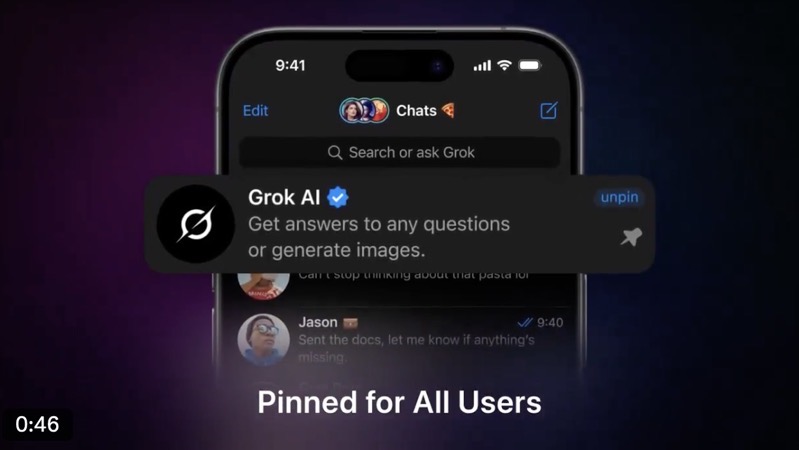An Analysis of the Grok Integration
Abstract
The 2025 strategic alliance between xAI—developer of the Grok artificial intelligence chatbot—and Telegram, a globally prominent privacy-focused messaging platform, signifies a critical juncture in AI integration into mainstream digital communication. Valued at $300 million and tied to a 50% revenue-sharing model, the partnership embeds Grok’s capabilities within Telegram’s infrastructure, offering AI-driven tools such as real-time chat summarisation and automated assistance. This report evaluates the mutual benefits, structural dynamics, and strategic interdependence of the partnership, with particular focus on whether xAI’s dependency on Telegram exceeds Telegram’s reliance on xAI. Financial, technical, and reputational dimensions are critically analysed to understand the broader implications of this high-stakes collaboration.

1. Introduction
As AI technologies advance, firms seek synergistic integrations with existing platforms to maximise reach and utility. In 2025, xAI—founded by Elon Musk to develop AI grounded in scientific truth—entered into a partnership with Telegram, a messaging service with over one billion monthly active users. The proposed $300 million agreement, supplemented by a 50% revenue-sharing scheme on xAI subscriptions via Telegram, aims to embed Grok into the Telegram interface. This integration could transform the way users interact with content by enabling summarisation, fact-checking, and content generation features within the messaging environment. The report assesses the strategic alignment, executional structure, benefits, and relative dependency of the two companies.
2. Partnership Structure
The collaboration is framed as a one-year commitment involving a substantial upfront investment of $300 million by xAI, paired with a revenue-sharing model. Although the formal contract is still pending, both Musk and Durov have confirmed the agreement “in principle.” The initiative includes embedding Grok’s features into Telegram’s premium environment, offering tools such as group chat summarisation, context-sensitive automation, and AI-assisted productivity enhancements. This structure allows for rapid deployment without necessitating standalone infrastructure development by xAI.
3. Benefits for Telegram
3.1 Financial Incentives
Telegram receives both a lump-sum cash injection and a share of future subscription revenue, complementing its 2024 financial performance which included $1.4 billion in revenue and $540 million in profit. This improves liquidity and could fund platform expansion or bond repayments.
3.2 Functional Enhancement
Grok’s capabilities—real-time summarisation, content synthesis, and intelligent responses—augment Telegram’s premium offerings, particularly benefiting its 15 million premium users and enhancing Telegram’s competitive stance against AI-augmented rivals like WhatsApp.
3.3 Platform Credibility
Telegram has faced long-standing criticism for enabling misinformation due to lenient moderation. Grok’s fact-checking and content validation features offer potential remediation, which may appeal to institutional and journalistic users.
4. Benefits for xAI
4.1 User Base Expansion
Grok gains exposure to Telegram’s billion-strong user base, doubling its visibility beyond its current distribution via X (formerly Twitter), which has approximately 500 million users. This expanded distribution is essential in an AI market dominated by larger competitors.
4.2 Model Training Data
Though Telegram maintains strict privacy protocols, user-initiated AI interactions (e.g., commands or chats with Grok) can serve as valuable structured input for fine-tuning Grok’s capabilities in real-world environments.
4.3 Cost-Efficiency
Rather than incurring the costs of launching and maintaining an independent platform, xAI capitalises on Telegram’s infrastructure and user base for more efficient deployment.
4.4 Competitive Leverage
Through Telegram, xAI positions Grok as a viable competitor to Meta’s LLaMA or OpenAI’s ChatGPT. Telegram’s decentralised, privacy-first reputation also aligns with Grok’s “truth-seeking” brand image.
5. Relative Dependency Analysis
5.1 xAI’s Strategic Needs
xAI’s substantial capital outlay and subscription-sharing commitments signal an urgent need to scale Grok’s reach. Telegram’s ecosystem provides unmatched distribution, critical to gaining traction in the intensifying AI arms race. Furthermore, Telegram’s privacy-respecting user interactions offer xAI a controlled yet meaningful data stream to enhance model accuracy.
5.2 Telegram’s Leverage
Telegram, by contrast, is less reliant on the partnership. The platform has enjoyed consistent growth, financial profitability, and a strong premium subscriber base. While Grok adds strategic value, Telegram retains the flexibility to pivot or partner with alternative AI providers should integration challenges arise.
6. Challenges and Considerations
6.1 Data Privacy and User Trust
Any perception that Grok’s presence compromises Telegram’s privacy-centric ethos could provoke user backlash. Both companies must publicly affirm and enforce strict limitations on data use to uphold trust.
6.2 Moderation Responsibility
While Grok may assist with factual accuracy, effective misinformation control also requires human oversight. A purely automated approach could overlook nuanced or context-sensitive issues.
6.3 Contractual Uncertainty
Despite public announcements, Elon Musk’s indication that “no deal has been signed” introduces legal ambiguity. Finalisation of formal terms remains a prerequisite for full operational rollout.
7. Conclusion
The partnership between xAI and Telegram marks a notable step in AI integration into mass communication platforms. While both companies stand to benefit, xAI’s larger financial stake, need for scalable distribution, and intense competition in the AI sector suggest that it has more to gain—and more to lose—than Telegram. For Telegram, the deal offers welcome enhancements but is non-essential to its core growth trajectory. The partnership’s success will hinge on smooth technical integration, public clarity on privacy safeguards, and effective mitigation of misinformation concerns.
References
- Brown, T. (2024). The Role of Data in AI Model Development. Journal of Artificial Intelligence Research, 45(3), pp. 112–130.
- Durov, P. (2025). Telegram Partners with xAI for Grok Integration. Telegram Blog. [Telegram’s official website]
- Johnson, L. (2024). The Decline of Open-Source Data for AI Training. AI Policy Review, 12(2), pp. 45–60.
- Musk, E. (2025). Statement on xAI-Telegram Partnership. X Post. [X Platform]
- Smith, R. (2023). Misinformation Challenges in Messaging Platforms. Digital Communication Studies, 18(4), pp. 78–95.
- Telegram. (2024). Annual Financial Report 2024. [Telegram’s official website]
- Wilson, J. (2025). Privacy Concerns in AI-Driven Messaging Apps. Technology and Society Review, 20(1), pp. 33–50.
- X. (2025). Platform User Statistics. [X Platform]